您好,登錄后才能下訂單哦!
您好,登錄后才能下訂單哦!
這篇文章將為大家詳細講解有關SpringBoot 中Security如何使用,文章內容質量較高,因此小編分享給大家做個參考,希望大家閱讀完這篇文章后對相關知識有一定的了解。
Security是Spring全家桶中一個安全框架,他的擴展能力非常的強,底層是一條過濾器鏈。通過簡單的配置就可以使用,但通過自己的DIY,可以把每個權限細化到每個鏈接上去。
shiro沒有學,但只推薦學一個安全框架
這里搭建的學習項目都是使用SpringBoot
你可以在maven官網獲取最新版本
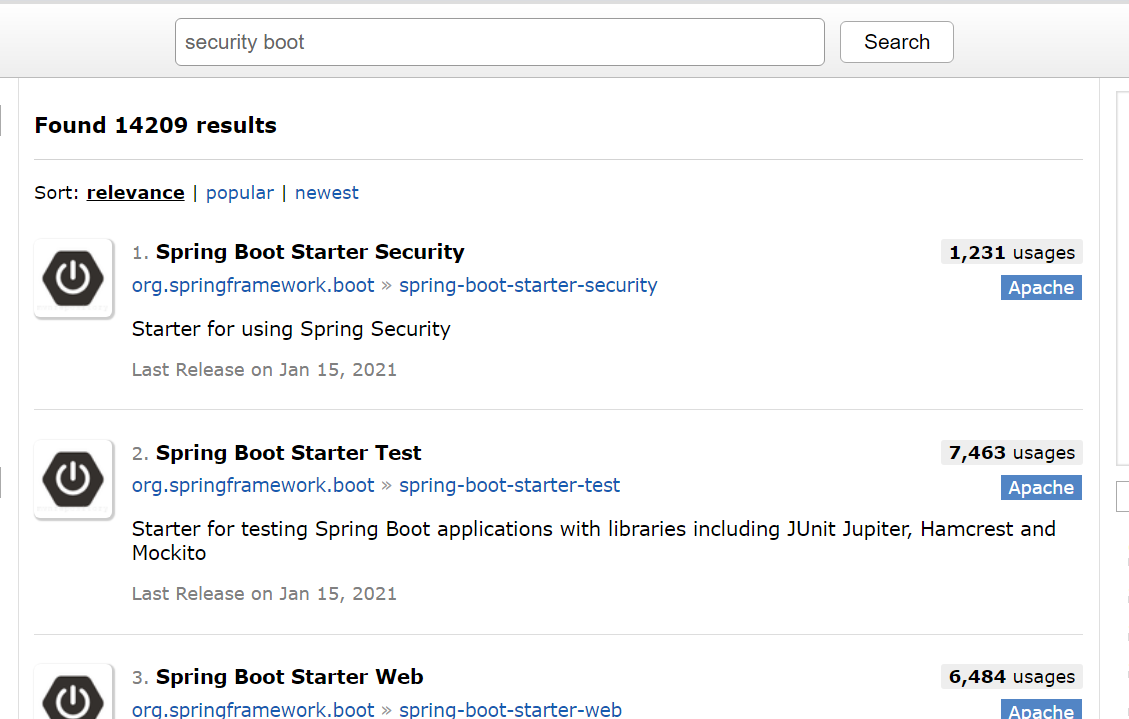
<dependency> <groupId>org.springframework.boot</groupId> <artifactId>spring-boot-starter-security</artifactId> <version>2.4.2</version> </dependency>
<?xml version="1.0" encoding="UTF-8"?> <project xmlns="http://maven.apache.org/POM/4.0.0" xmlns:xsi="http://www.w3.org/2001/XMLSchema-instance" xsi:schemaLocation="http://maven.apache.org/POM/4.0.0 https://maven.apache.org/xsd/maven-4.0.0.xsd"> <modelVersion>4.0.0</modelVersion> <parent> <groupId>org.springframework.boot</groupId> <artifactId>spring-boot-starter-parent</artifactId> <version>2.4.2</version> <relativePath/> <!-- lookup parent from repository --> </parent> <groupId>com.pipihao</groupId> <artifactId>securitylearn</artifactId> <version>0.0.1-SNAPSHOT</version> <name>securitylearn</name> <description>Demo project for Spring Boot</description> <properties> <java.version>1.8</java.version> </properties> <dependencies> <dependency> <groupId>com.alibaba</groupId> <artifactId>druid</artifactId> <version>1.1.21</version> </dependency> <dependency> <groupId>org.springframework.boot</groupId> <artifactId>spring-boot-starter-thymeleaf</artifactId> </dependency> <dependency> <groupId>org.springframework.boot</groupId> <artifactId>spring-boot-starter-security</artifactId> </dependency> <dependency> <groupId>org.springframework.boot</groupId> <artifactId>spring-boot-starter-web</artifactId> </dependency> <dependency> <groupId>org.mybatis.spring.boot</groupId> <artifactId>mybatis-spring-boot-starter</artifactId> <version>2.1.4</version> </dependency> <dependency> <groupId>mysql</groupId> <artifactId>mysql-connector-java</artifactId> <scope>runtime</scope> </dependency> <dependency> <groupId>org.projectlombok</groupId> <artifactId>lombok</artifactId> <optional>true</optional> </dependency> <dependency> <groupId>org.springframework.boot</groupId> <artifactId>spring-boot-starter-test</artifactId> <scope>test</scope> </dependency> <dependency> <groupId>org.springframework.security</groupId> <artifactId>spring-security-test</artifactId> <scope>test</scope> </dependency> </dependencies> <build> <plugins> <plugin> <groupId>org.springframework.boot</groupId> <artifactId>spring-boot-maven-plugin</artifactId> <configuration> <excludes> <exclude> <groupId>org.projectlombok</groupId> <artifactId>lombok</artifactId> </exclude> </excludes> </configuration> </plugin> </plugins> </build> </project>
server: port: 8001 spring: datasource: url: jdbc:mysql://localhost:3306/demo?serverTimezone=Asia/Shanghai username: root password: root driver-class-name: com.mysql.cj.jdbc.Driver thymeleaf: cache: false # 因為Thymeleaf很多有默認配置,所以只關了這個緩存,方便刷新
數據庫版本為 8.0
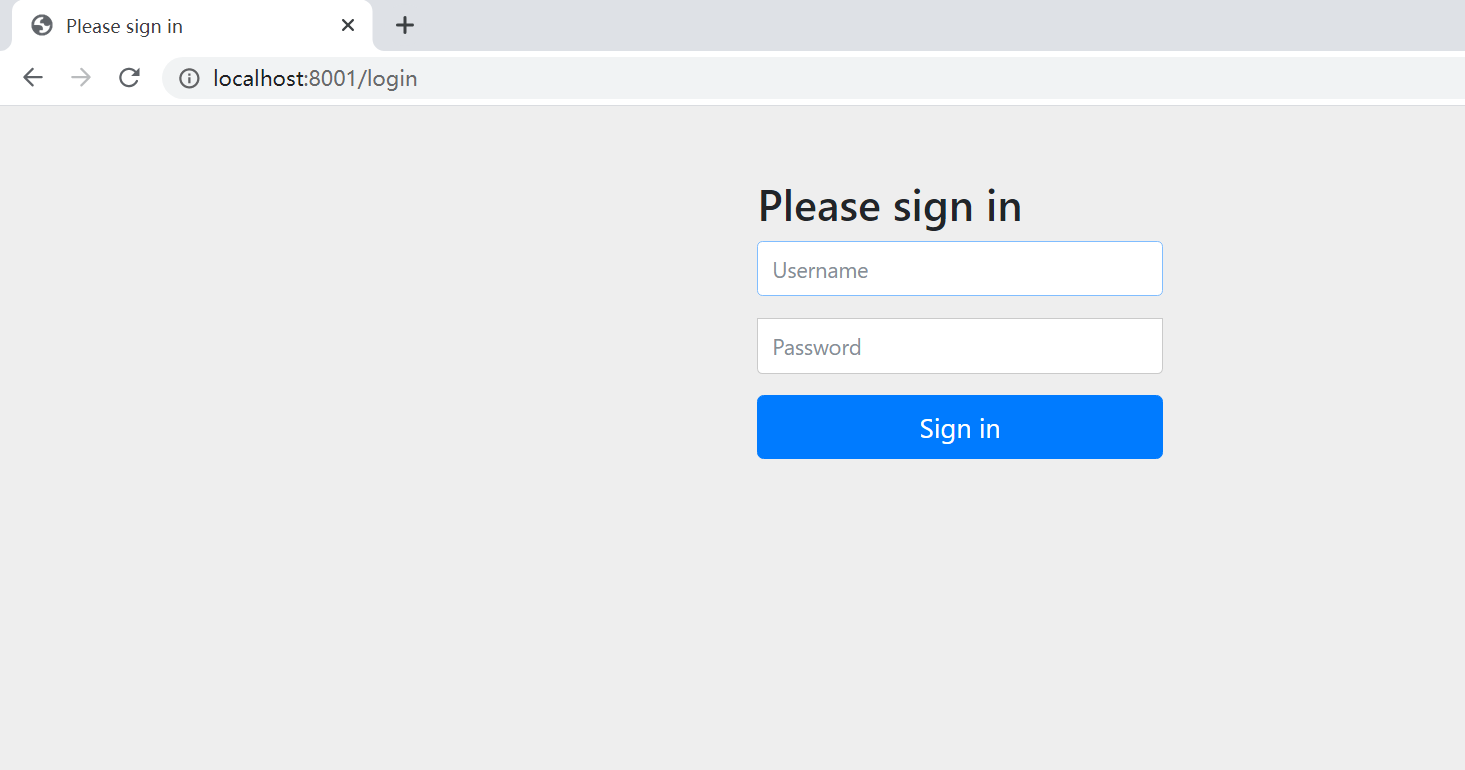
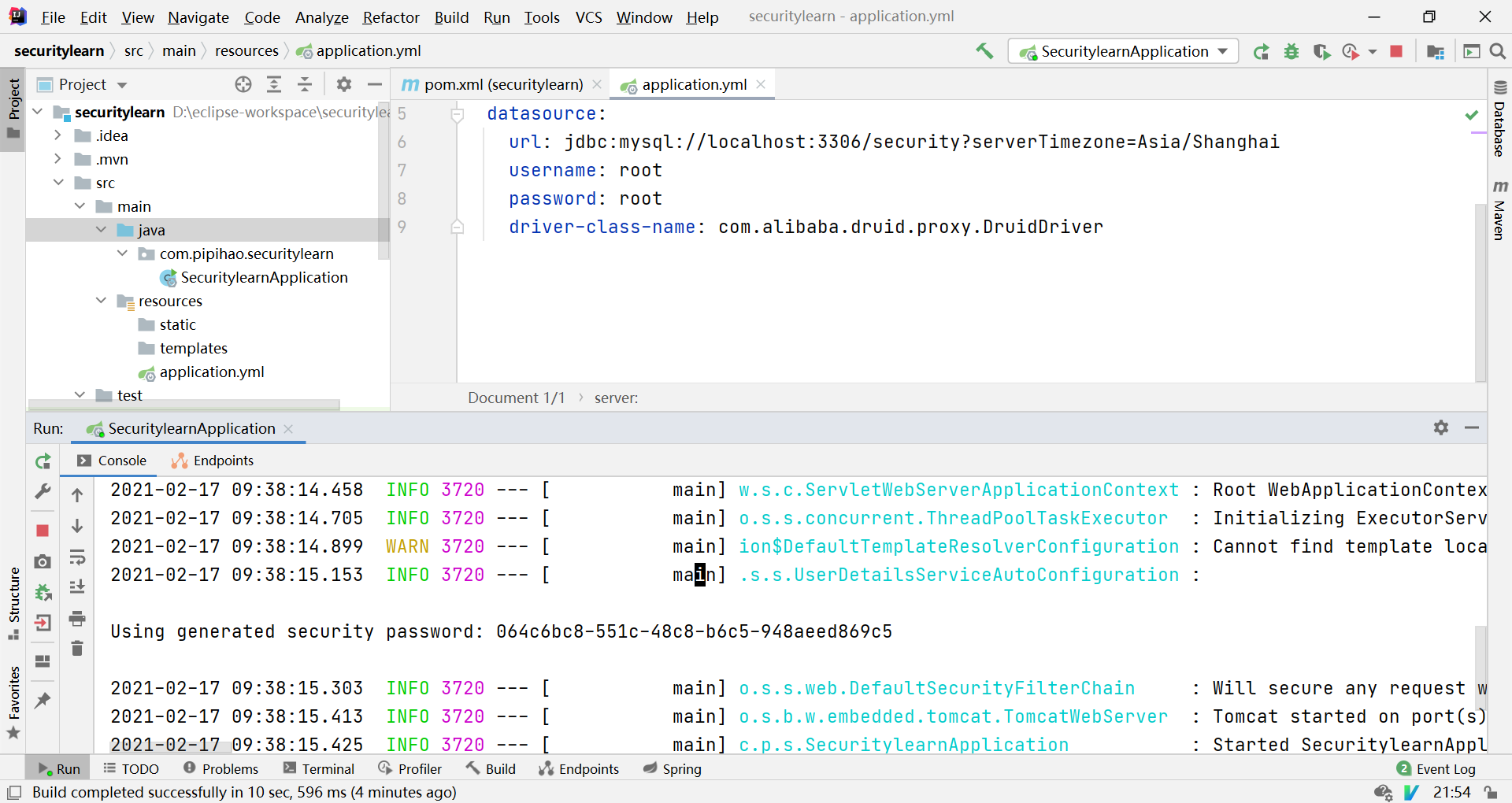
用戶名:user
密碼:控制臺輸出的這密碼
spring: security: user: name: xx password: xx
WebSecurityConfigurerAdapter 類是是Security內置提供了一個默認身份驗證的抽象類,繼承此抽象類實現configure方法則可以對驗證操作實現DIY。[于官方文檔 6.3 標題可見]
UserDetailsService接口:查詢數據庫用戶名和密碼過程
創建類繼承UsernamePasswordAuthenticationFilter,重寫三個方法
*
創建類實現UserDetailService,編寫查詢數據過程,返回User對象,這個User對象是安全框架提供對象。
PasswordEncoder: 數據加密接口,用于返回User對象里面的密碼加密
@Override
protected void configure(HttpSecurity http) throws Exception {
/*
使用and()方法表示關閉XML標記的Java配置,它允許我們繼續配置父標記。如果您閱讀代碼,它也是有道理的。我想配置授權請求并配置表單登錄并配置HTTP基本身份驗證。
*/
http
.authorizeRequests()
.antMatchers("/","/no").permitAll() //可以直接訪問的路徑
.anyRequest().authenticated()
.and()
.formLogin()
.loginPage("/login.html") //配置登錄路徑
.loginProcessingUrl("/doLogin")
.defaultSuccessUrl("/hallo")
.permitAll()
; //設置 登錄的網頁
http.csrf().disable(); //如果注釋了這一行,全部要用_csrf的對象來驗證了
}如果是配置訪問角色則使用是hasRole與hasAnyRole
這里非常建議點一下看一下hasRole的源碼 使用Role的時候,User的權限列表是需要加ROLE_前綴的
這里直接使用的是hasAnyAuthority,還有一個方法是hasAuthority
前者可以配置多個權限,而后者只能配置一個權限
接口只是顯示一個字符串
@GetMapping("test") public String sayTest(){ return "Test"; }
@Override
protected void configure(HttpSecurity http) throws Exception {
/*
使用and()方法表示關閉XML標記的Java配置,它允許我們繼續配置父標記。如果您閱讀代碼,它也是有道理的。我想配置授權請求并配置表單登錄并配置HTTP基本身份驗證。
*/
http
.authorizeRequests()
.antMatchers("/","/no").permitAll() //可以直接訪問的路徑
.antMatchers("/test").hasAnyAuthority("admin") // 訪問權限
.anyRequest().authenticated()
.and()
.formLogin()
.loginPage("/login.html") //配置登錄路徑
.loginProcessingUrl("/doLogin")
.defaultSuccessUrl("/hallo")
.permitAll()
; //設置 登錄的網頁
http.csrf().disable(); //如果注釋了這一行,全部要用_csrf的對象來驗證了
}@Override
public UserDetails loadUserByUsername(String username) throws UsernameNotFoundException {
if(StringUtils.isEmpty(username)){
throw new RuntimeException("用戶名不能為空");
}
IUser iUser= userMapper.getUserByUsername(username);
if(iUser == null){
throw new UsernameNotFoundException("無此用戶");
}
/*此處查詢用戶角色*/
List<GrantedAuthority> grantedAuthorityList =
AuthorityUtils.createAuthorityList("admin"); // 權限的列表
return new User(iUser.getUsername(),bCryptPasswordEncoder.encode(iUser.getPassword()),grantedAuthorityList);
}// 在此方法內加上一行 protected void configure(HttpSecurity http)
http.exceptionHandling().accessDeniedPage("/unauth.html");判斷是否有角色,這里匹配的角色需要加前綴ROLE_
@GetMapping("update")
@Secured({"ROLE_manager"})
public String update(){
return "update";
}使用其功能時需要在application類上開起
@SpringBootApplication
@MapperScan("com.pipihao.securitylearn.mapper")
@EnableGlobalMethodSecurity(securedEnabled = true)
public class SecuritylearnApplication {
public static void main(String[] args) {
SpringApplication.run(SecuritylearnApplication.class, args);
}
}UserDetailsServiceImpl
List<GrantedAuthority> grantedAuthorityList =
AuthorityUtils.createAuthorityList("admin","ROLE_manager");此注解即有權限驗證功能,又有角色驗證功能
@GetMapping("pre1")
@PreAuthorize("hasAnyRole('ROLE_manager')")
public String prePost1(){
return "prePost1";
}
@GetMapping("pre2")
@PreAuthorize("hasAnyAuthority('admin')")
public String prePost2(){
return "prePost2";
}@SpringBootApplication
@EnableGlobalMethodSecurity(prePostEnabled = true)
public class SecuritylearnApplication {
public static void main(String[] args) {
SpringApplication.run(SecuritylearnApplication.class, args);
}
}@PostAuthorize 與@PreAuthorize的區別就是,Pre會先攔截后執行,而PostAuthorize是先執行,后攔截
所以我例子中沒有過多的講
Pre是過濾上傳的數據,Post過濾返回的數據
@GetMapping("list")
@PostFilter("filterObject.username != 'admin' ")
public List<IUser> list(){
List<IUser> iUsers = new ArrayList<>();
iUsers.add(new IUser(1,"admin","123"));
iUsers.add(new IUser(2,"user","123"));
return iUsers;
}
// Applicationo類上還是要加上下面這個注解,并設置屬性值
@EnableGlobalMethodSecurity(prePostEnabled = true)效果圖
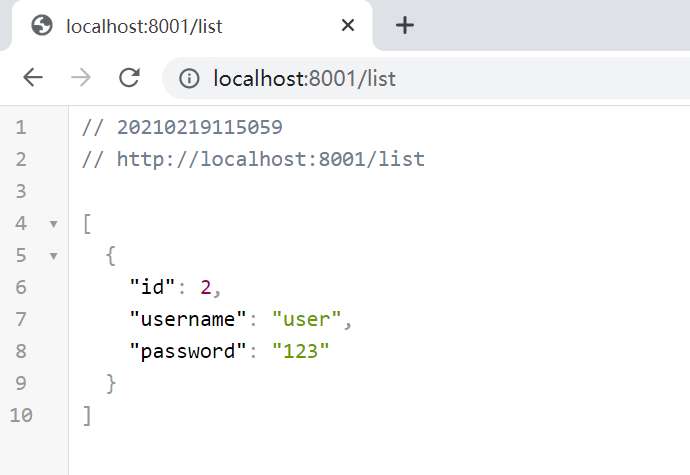
上傳則是同理,通過注解寫好判斷,然后測試即可,注:PreFilter過濾的也只是集合和數組
/*配置退出登錄*/
http.logout().logoutUrl("/logout").logoutSuccessUrl("no").permitAll();登錄后,直接通過瀏覽器,訪問此路徑即可(是的,就是如此)
location.href='/logout';
下面是尚硅谷老師寫的原理圖和執行流程
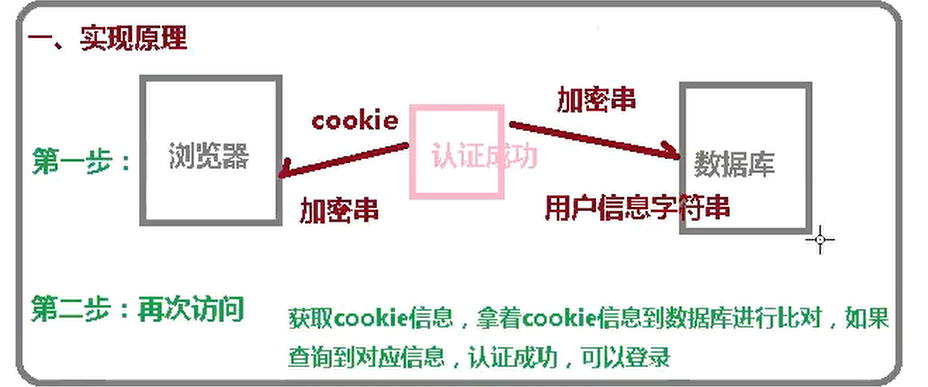
如果是微服務,則把數據庫改成redis,把cookie改成jwt生成的token
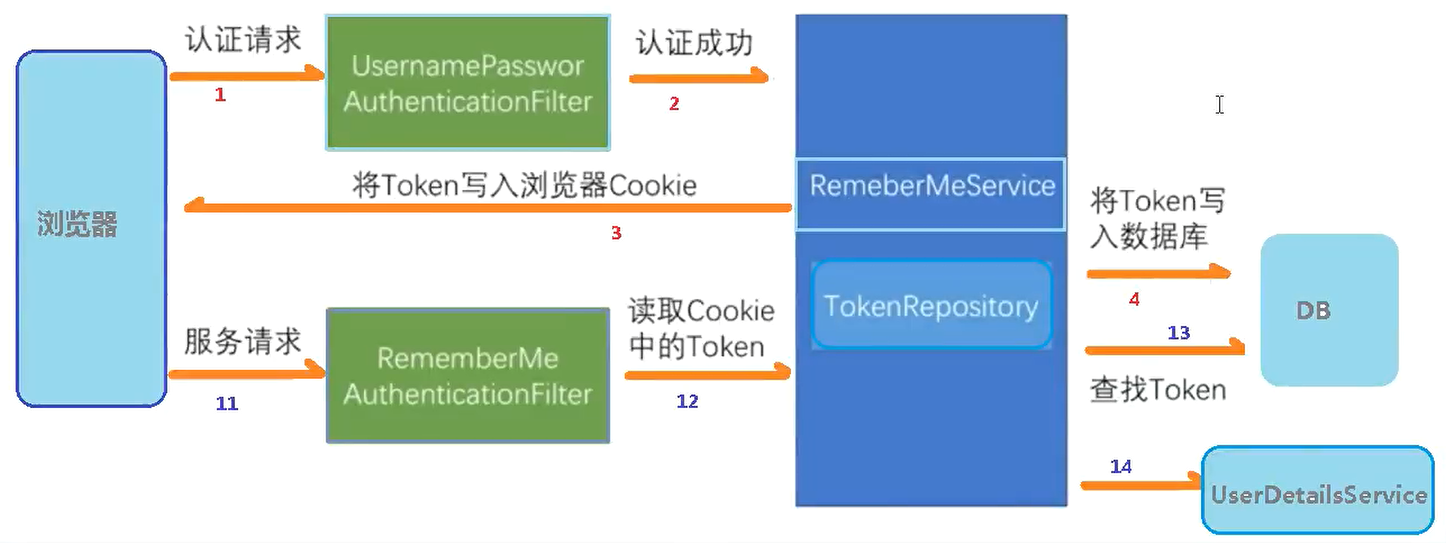
Security 中的一個類內JdbcTokenRepositoryImpl
的常量CREATE_TABLE_SQL
create table persistent_logins (username varchar(64) not null, series varchar(64) primary key, token varchar(64) not null, last_used timestamp not null)
有興趣的可以看看源碼 沒興趣的直接在你使用的數據庫內執行上面這行sql創建一個保存登錄信息的表

JdbcTokenRepositoryImpl 是PersistentTokenRepository實現類
下面這種寫那么應該是多態了
@Autowired
private DataSource dataSource;
@Bean
public PersistentTokenRepository persistentTokenRepository(){
JdbcTokenRepositoryImpl jdbcTokenRepository = new JdbcTokenRepositoryImpl();
jdbcTokenRepository.setDataSource(dataSource);
//jdbcTokenRepository.setCreateTableOnStartup(true); 設置啟動時創建自動登錄表
return jdbcTokenRepository;
}SecurityConfig的方法
@Override
protected void configure(HttpSecurity http) throws Exception {
/*自定義403鏈接*/
http.exceptionHandling().accessDeniedPage("/unauth.html");
/*配置退出登錄*/
http.logout().logoutUrl("/logout").logoutSuccessUrl("/no").permitAll();
/*
使用and()方法表示關閉XML標記的Java配置,它允許我們繼續配置父標記。如果您閱讀代碼,它也是有道理的。我想配置授權請求并配置表單登錄并配置HTTP基本身份驗證。
*/
http
.authorizeRequests()
.antMatchers("/","/no").permitAll() //可以直接訪問的路徑
.antMatchers("/test").hasAnyAuthority("admin")
.antMatchers("/unauth").hasAnyAuthority("xxx")
.anyRequest().authenticated()
.and()
.formLogin()
.loginPage("/login.html") //配置登錄路徑
.loginProcessingUrl("/doLogin")
.defaultSuccessUrl("/hallo")
.permitAll()
// -------------------就是下面這坨
.and()
.rememberMe().tokenRepository(persistentTokenRepository())
.tokenValiditySeconds(60) // 自動保存的時間,秒為單位
.userDetailsService(userDetailsService)
; //設置 登錄的網頁
http.csrf().disable(); //如果注釋了這一行,全部要用_csrf的對象來驗證了
}下面是登錄界面
<form action="/doLogin" method="POST"> user:<input type="text" name="username"><br> pswd:<input type="text" name="password"><br> <!--必須name=remember-me不然,是無法接收到是否自動登錄的信息的--> 自動登錄 <input type="checkbox" name="remember-me"><br> <input type="submit"> </form>
然后在登錄的時候打個勾,就可以自動登錄了
在DB中會出現如下的信息

第一步 把下面這一行注釋了就開啟了,也就是說他其實是默認開啟的
如果沒有關閉,則會NullPointerException
//http.csrf().disable();
Spring Security CSRF 會針對Patch,Post,Put,Delete方法進行防護。(都是一些要更改數據的方法)
系統默認提供了一個csrfToken對象放在HttpSession中,也就是我們所見到了_csrf對象
此對象可以直接使用
開啟CSRF后,則登錄的時【POST】,也需要驗證CSRF,而使用HttpSession則需要使用模板引擎,這里我們使用的是Thymeleaf而非JSP。(大同小異)
注:使用Thymeleaf的時候,類上的Controller注解不能寫成RestController,不然無法生效的
@Controller
public class LoginController {
@GetMapping("login")
public String login(){
return "login";
}
}<!doctype html> <html xmlns:th="http://www.thymeleaf.org"> <head> <meta charset="UTF-8"> <meta name="viewport" content="width=device-width, user-scalable=no, initial-scale=1.0, maximum-scale=1.0, minimum-scale=1.0"> <meta http-equiv="X-UA-Compatible" content="ie=edge"> <title>登錄</title> </head> <body> <!--沒加th:則不會有隱藏域自動生成--> <form th:action="'/doLogin'" method="POST"> user:<input type="text" name="username"><br> pswd:<input type="text" name="password"><br> <!--必須name=remember-me不然,是無法接收到是否自動登錄的信息的--> 自動登錄 <input type="checkbox" name="remember-me"><br> <input type="submit"> </form> </body> </html>
切記,默認開了CSRF,則每個表單中應當手動添加一個隱藏域
當Thymeleaf因為你使用了th,則自動給你生成了。
所以 th:action="'/doLogin'" 這樣寫可以省事
如下圖

關于SpringBoot 中Security如何使用就分享到這里了,希望以上內容可以對大家有一定的幫助,可以學到更多知識。如果覺得文章不錯,可以把它分享出去讓更多的人看到。
免責聲明:本站發布的內容(圖片、視頻和文字)以原創、轉載和分享為主,文章觀點不代表本網站立場,如果涉及侵權請聯系站長郵箱:is@yisu.com進行舉報,并提供相關證據,一經查實,將立刻刪除涉嫌侵權內容。